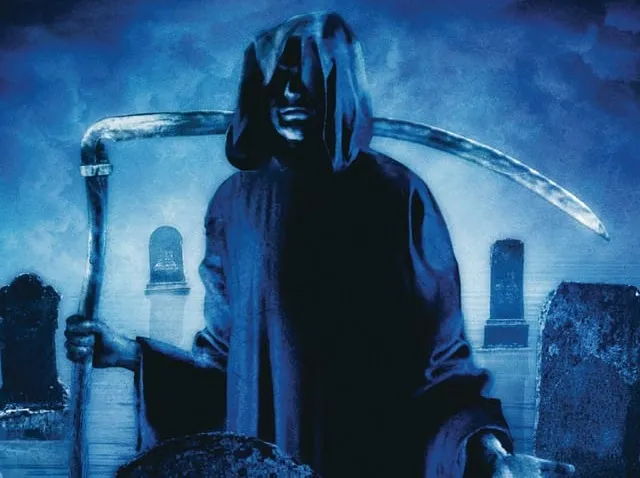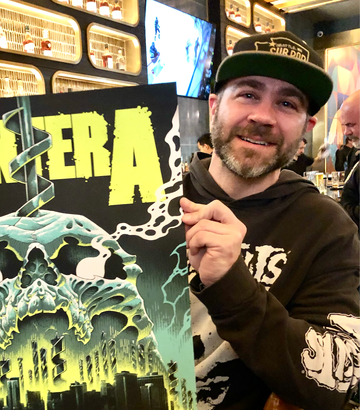“Death be not proud. Though some have called thee mighty and dreadful – thou art not so.”
There are very few moments I can recall where I’ve heard songs or albums that opened up a whole new world of music to me. One such occasion was listening to Master of Puppets for the first time through after being introduced to Metallica during the Load and Reload era. Another was hearing Opeth for the first time, either “Harvest” or “The Drapery Falls” from Blackwater Park. But maybe the most memorable for me was what I heard after the words above.
My initial reaction to hearing “Follow the Reaper” for the first time went exactly like this: “What the fuck am I listening to? …. this is awesome.” On paper, the combination of guitar shredding accentuated by synth-laden keyboards with barking black metal style vocals was a combination that could be a recipe for disaster. But the precision with which Children of Bodom executed this formula, combined with the group’s keen sense of melody, drew me in immediately. For all the technical excellence that’s thrust to the forefront on the first listen, what ultimately stuck with me with from the start was how catchy the leads and riffs from “Follow the Reaper” were.
At the time, I was around 15 years old and in high school. I can’t recall exactly how I first encountered Children of Bodom, though I definitely learned of them from the old metal message boards I’d peruse looking for new bands. My friends and I were all moving towards more extreme metal after running through the catalogs of Metallica, Megadeth, Slayer, and Iron Maiden. At some point, we were gathered in a friend’s basement, listening to Follow the Reaper with absolute awe. I may have brought it to the group after downloading a copy from Napster or Audiogalaxy (sorry boys – I did eventually buy a real copy once I tracked one down in store, as they were hard to come by in the early days).
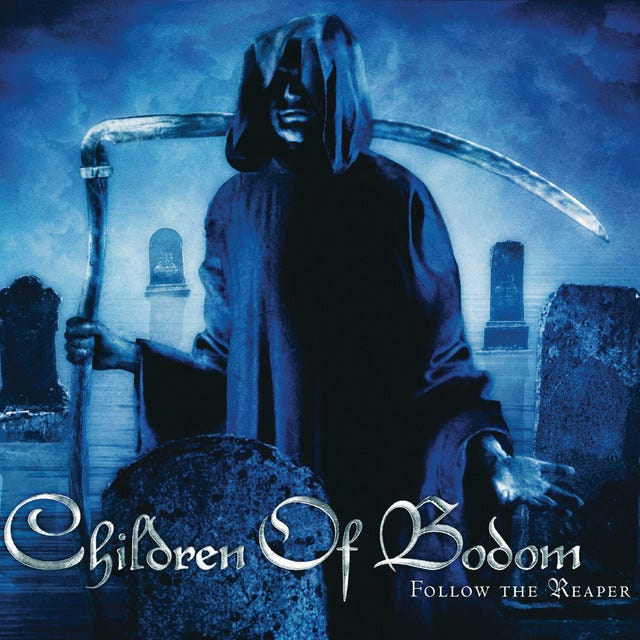
That first listen revealed a whole new world of metal for me that I was largely unfamiliar with previously, as well as a new band to obsess upon. Though the title track reeled me in, the rest of Side A is arguably the best in Children of Bodom’s entire catalog. “Bodom After Midnight” is a classic that became a staple in the band’s live set nearly to the very end of the band’s career, while the criminally underrated “Children of Decadence” features some of the finest leads Alexi Laiho ever composed. The so-called “ballad” of the album, meaning it was just written in a slower tempo, “Everytime I Die” would go on to be one of the group’s most recognizable songs due to it’s incredible composition and an ‘80s inspired solo duel between Laiho and keyboardist Janne Wirman, alongside an iconic performance of the song at Tuska 2003 in the band’s native Finland. The haunting keyboard melodies of “Mask of Sanity” help close out a flawless album side in style.
video credit: Sigfried38 on YouTube.
That’s not to sleep on Side B – “Taste of My Scythe,” though not given a ton of fanfare in the band’s catalog, features some majestic leads combined with the punishing rhythm of Jaska Raatikainen’s drums and a dazzling keyboard solo from Wirman. The apex of the album, “Hate Me,” is as anthemic of the band’s ethos as it is impressive as a composition. The lead single released the summer prior to the album’s proper reveal, Laiho described it as more of a rock ‘n roll song that gave the band a new direction to go in. There may be no better indicator of his songwriting brilliance than “Hate Me,” as it flawlessly combines death and power metal into digestible, catchy rock ‘n roll track that, at the risk of sounding heretical to the metal gods, has pop sensibility to it. “Northern Comfort,” a nod to the band’s discovery of Southern Comfort after playing in the United States for the first time at Milwaukee Metalfest, features “one of the best riffs in Children of Bodom history” about two and a half minutes into the song according to original rhythm guitarist Alexander Kuoppala. This tour de force of a record concludes with what would be the “Paranoid” of the band’s catalog, as “Kissing the Shadows” was written in studio when the group realized the run time for their third record was just shy of where it needed to be. The second half of the track features a furious back-and-forth solo battle between Laiho and Wirman, finishing off the album with what most would consider the trademark of the band’s sound.
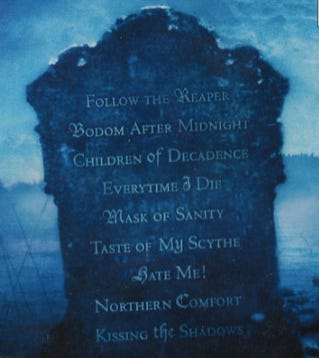
As important as this album was and is to me personally, it’s also arguably the most important record that Children of Bodom ever produced for a number of reasons. To this point, the group had released Something Wild (1997) and Hatebreeder (1999) to wild success in Finland, Europe, and as far reaching as Japan, which resulted in the release of the Tokyo Warhearts live album (1999). The desire to breakthrough in the United States, and more largely, North America was a large goal for Laiho and the group in general, who all shared a fondness of American pop culture. Though the Bodom boys wouldn’t embark on their first tour of the United States until 2003 after the release of Hate Crew Deathroll, I would argue that Follow the Reaper laid the groundwork for their rising popularity across the Atlantic. If my friends and I were becoming aware of them, how many other metal fans across the States were doing the same as us? Follow the Reaper opened the door for me to their entire back catalog, which I quickly purchased from the only record store that kept them in stock (RIP Slipped Disc in Valley Stream).
For the band itself, this record represents a bridge from their original sound to what they would eventually become on later albums, most notably Hate Crew Deathroll (2002) and Are You Dead Yet? (2005). Whereas Something Wild (1997) and Hatebreeder (1999) were heavily focused on a neoclassical, breakneck-pace style, the songwriting on Follow the Reaper gives an indication of where the group was heading with their sound, especially when you consider tracks like “Everytime I Die” and “Hate Me.” The third record focuses slightly less of showcasing the tremendous acumen of every player in the group and more on writing incredible songs and hooks, regardless of what style those tracks may be labeled as, while incorporating some of that ‘80s glam sound that inspired them.
Make no mistake – Hatebreeder is a godly album, but Follow the Reaper displays a more refined approach to songwriting that makes these incredibly complex songs accessible to the average listener – like, hypothetically, a teenager from Long Island. That trend in the band’s songwriting approach would continue to be crafted and perfected on their future records for the rest of their existence. This evolution would greatly reshape the trajectory of the band, as they would eventually land three consecutive records atop the Finnish charts, which is an astounding accomplishment for a metal band in any country, and go on to become one of the most, if not the most, renowned and celebrated metal acts to ever come out of Finland.
Released on October 30, 2000, Follow the Reaper on the eve of its 25th birthday still plays through as harshly beautiful as the first time I heard it back in my friend’s basement. In fact, I have recently been down a Children of Bodom rabbit hole for the better part of this year that I have little hope of escaping any time soon, even after interviewing three former members of the band. I’ve arguably listened to Follow the Reaper more times this year than I did back when I first bought a legitimate copy and after two and a half decades, I feel like I have a greater appreciation for it now than even after the first time I heard the guitar harmonies from the title track.
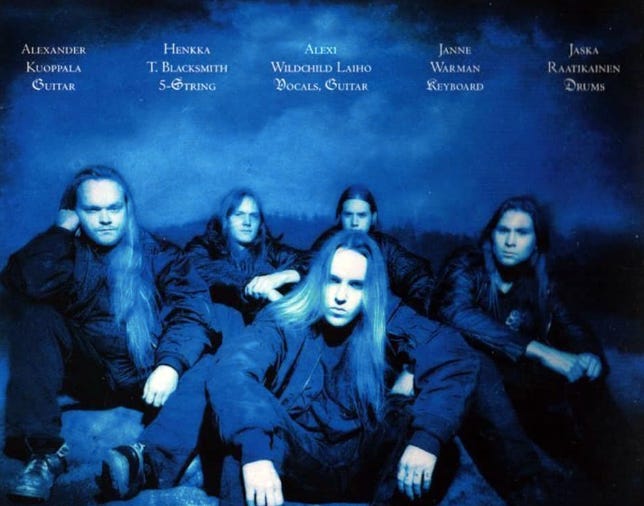
What truer test of an album’s greatness is there than to stand the test of time? For every record and band that capitalized on trends and gimmicks, the true classics age with grace and sound as if they could have been released in any era. The fact that these guys wrote it when they were barely 21 years old is an insane accomplishment that only adds to the band’s lore. Though the band members to a man generally say that their best album is Hate Crew Deathroll, for my money, Follow the Reaper is their true masterpiece that pushed them to the point of no return in terms of their sound and popularity worldwide. It is a crowning achievement not only in the band’s discography, but a watershed release in the history of heavy metal, and a testament to the brilliance of Children of Bodom and the immortal legacy of Alexi Laiho.
Here’s to the next 25 years! In the meantime, if you need me, I’ll be listening to the last two minutes of “Kissing the Shadows” on loop until then.
video credit: Hautaamaki on YouTube.
In case you missed them, here are my interviews with Antti and Janne Wirman, and Alexander Kuoppala, all of whom played in Children of Bodom.

